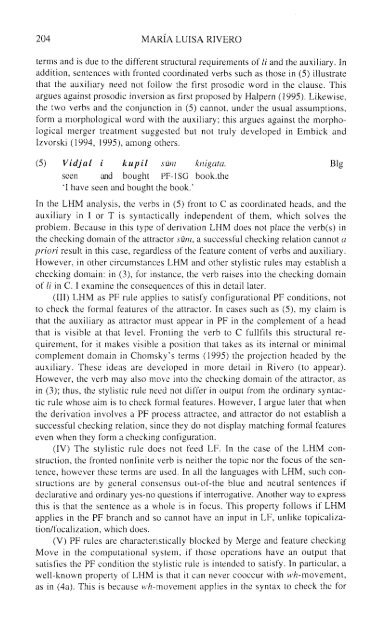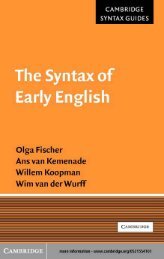Comparative Syntax of the Balkan Languages (Oxford ... - Cryptm.org
Comparative Syntax of the Balkan Languages (Oxford ... - Cryptm.org
Comparative Syntax of the Balkan Languages (Oxford ... - Cryptm.org
- No tags were found...
You also want an ePaper? Increase the reach of your titles
YUMPU automatically turns print PDFs into web optimized ePapers that Google loves.
204 MARIA LUISA RIVEROterms and is due to <strong>the</strong> different structural requirements <strong>of</strong> li and <strong>the</strong> auxiliary. Inaddition, sentences with fronted coordinated verbs such as those in (5) illustratethat <strong>the</strong> auxiliary need not follow <strong>the</strong> first prosodic word in <strong>the</strong> clause. Thisargues against prosodic inversion as first proposed by Halpern (1995). Likewise,<strong>the</strong> two verbs and <strong>the</strong> conjunction in (5) cannot, under <strong>the</strong> usual assumptions,form a morphological word with <strong>the</strong> auxiliary; this argues against <strong>the</strong> morphologicalmerger treatment suggested but not truly developed in Embick andIzvorski (1994, 1995), among o<strong>the</strong>rs.(5) Vidjallseen/'andkupilbought'I have seen and boughtsumPF-1SG<strong>the</strong> book.knigata.book. <strong>the</strong>In <strong>the</strong> LHM analysis, <strong>the</strong> verbs in (5) front to C as coordinated heads, and <strong>the</strong>auxiliary in I or T is syntactically independent <strong>of</strong> <strong>the</strong>m, which solves <strong>the</strong>problem. Because in this type <strong>of</strong> derivation LHM does not place <strong>the</strong> verb(s) in<strong>the</strong> checking domain <strong>of</strong> <strong>the</strong> attractor sum, a successful checking relation cannot apriori result in this case, regardless <strong>of</strong> <strong>the</strong> feature content <strong>of</strong> verbs and auxiliary.However, in o<strong>the</strong>r circumstances LHM and o<strong>the</strong>r stylistic rules may establish achecking domain: in (3), for instance, <strong>the</strong> verb raises into <strong>the</strong> checking domain<strong>of</strong> li in C. I examine <strong>the</strong> consequences <strong>of</strong> this in detail later.(III) LHM as PF rule applies to satisfy configurational PF conditions, notto check <strong>the</strong> formal features <strong>of</strong> <strong>the</strong> attractor. In cases such as (5), my claim isthat <strong>the</strong> auxiliary as attractor must appear in PF in <strong>the</strong> complement <strong>of</strong> a headthat is visible at that level. Fronting <strong>the</strong> verb to C fullfils this structural requirement,for it makes visible a position that takes as its internal or minimalcomplement domain in Chomsky's terms (1995) <strong>the</strong> projection headed by <strong>the</strong>auxiliary. These ideas are developed in more detail in Rivero (to appear).However, <strong>the</strong> verb may also move into <strong>the</strong> checking domain <strong>of</strong> <strong>the</strong> attractor, asin (3); thus, <strong>the</strong> stylistic rule need not differ in output from <strong>the</strong> ordinary syntacticrule whose aim is to check formal features. However, I argue later that when<strong>the</strong> derivation involves a PF process attractee, and attractor do not establish asuccessful checking relation, since <strong>the</strong>y do not display matching formal featureseven when <strong>the</strong>y form a checking configuration.(IV) The stylistic rule does not feed LF. In <strong>the</strong> case <strong>of</strong> <strong>the</strong> LHM construction,<strong>the</strong> fronted nonfinite verb is nei<strong>the</strong>r <strong>the</strong> topic nor <strong>the</strong> focus <strong>of</strong> <strong>the</strong> sentence,however <strong>the</strong>se terms are used. In all <strong>the</strong> languages with LHM, such constructionsare by general consensus out-<strong>of</strong>-<strong>the</strong> blue and neutral sentences ifdeclarative and ordinary yes-no questions if interrogative. Ano<strong>the</strong>r way to expressthis is that <strong>the</strong> sentence as a whole is in focus. This property follows if LHMapplies in <strong>the</strong> PF branch and so cannot have an input in LF, unlike topicalizalion/focalization,which does.(V) PF rules are characteristically blocked by Merge and feature checkingMove in <strong>the</strong> computational system, if those operations have an output thatsatisfies <strong>the</strong> PF condition <strong>the</strong> stylistic rule is intended to satisfy. In particular, awell-known property <strong>of</strong> LHM is that it can never cooccur with wh-movement,as in (4a). This is because wh-movement applies in <strong>the</strong> syntax to check <strong>the</strong> forBlg
















